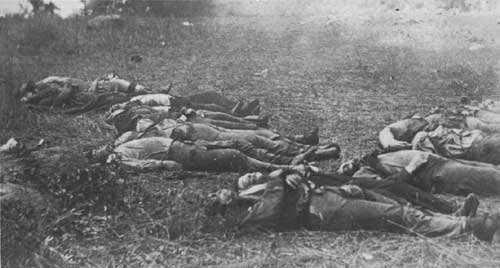|
THE CAMPAIGN ENDS
General Lee and others worked to prepare for a Union counterattack.
That night Lee pulled Ewell's Corps from its positions in the town and
opposite Culp's Hill back to Seminary Ridge, and the Confederate army
spent a rainy Independence Day awaiting an attack from Meade's army that
did not come. As it waited it prepared to return to Virginia. A wagon
train seventeen miles long bearing many of its wounded was the first of
Lee's army away, grinding slowly over Cashtown Pass in a rainstorm. The
main army marched to the Hagerstown area via Monterey Pass. The last of
it, Ewell's Corps, moved off on the morning of July 5 and two days later
reached the Hagerstown area. There Lee found the Potomac River too
swollen to cross. He placed his army in a strong defensive position and
prepared for an attack while he waited for the river to fall.
The Army of the Potomac, which had also been damaged severely and was
short of rations and other supplies, slogged to the Hagerstown area, not
over the direct route taken by Lee but by way of Frederick, where it met
its trains and got some needed supplies. From there it crossed the
mountains to the west. It reached the Hagerstown area in force and on
July 11th and 12th reconnoitered and deployed in front of the
Confederate defenses. Heavy rains made all movement difficult. There
were reconnaissances on the 13th, and Meade ordered
reconnaissances-in-force on the following morning. The Army of the
Potomac pushed forward on the 14th, but it was too late. The Potomac had
subsided enough so that the Confederates had been able to cross it
during the night, and Federal cavalry found only a rear guard at the
pontoon bridge at Falling Waters, Maryland. Lee's army had returned to
Virginia, his campaign over.

|
CONFEDERATE'S DEAD AT ROSE'S WOODS (CWL)
|
The numbers of casualties were huge. The Confederates reported
20,451, but there could have been as many as 7,000 more who were
captured and not included in this figure. The reported Union count was
23,049, including one corps commander killed and two seriously wounded.
Lee had accomplished some of his objectives: he had removed the war from
Virginia for a few weeks, and his army had collected valuable supplies.
But he had lost the decisive battle and had returrned to Virginia with a
crippled army that never again, in the two years of war that followed,
would be able to launch a major offensive. The march from Gettysburg led
eventually to Appomattox.
|
|
